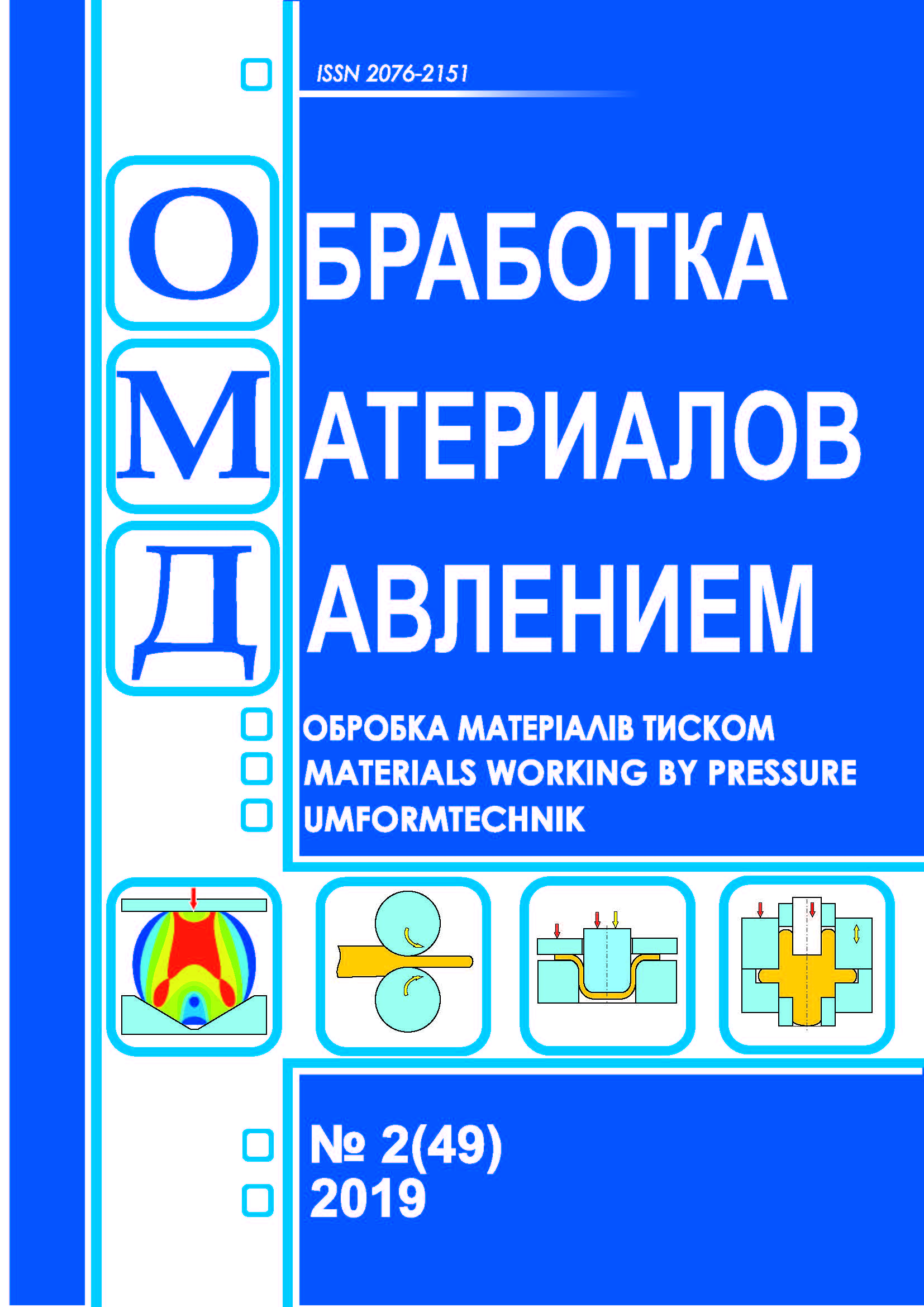Contact wire and methods for its manufacture
DOI:
https://doi.org/10.37142/2076-2151/2019-2(49)177Keywords:
copper; copper alloys; reinforced electrical contact wire; Conform-process.Abstract
Fedorinov V. A., Fedorinov M. V., Kulik A. N., Kokh A. K. Contact wire and methods for its manufacture // Material working by pressure. – 2019. – № 2 (49). - С. 177-188.
The results of a patent and literature review of the design and methods for making an electrical contact wire designed to transmit electric energy to rolling stock of railways and electrified municipal transport are presented. Methods of manufacturing a contact wire are largely dependent on its design. Three main types of contact wires can be distinguished. These include: wire from a homogeneous metal or alloy based on it; a metal wire that has a variable chemical composition, varying, for example, from the chemical composition of copper to the chemical composition of an alloy based on it or with a variable structure; reinforced wire, obviously heterogeneous in cross section, consisting of a steel core and a copper (sometimes aluminum) shell. It has been established that the most acceptable solution to the problem of increasing the strength characteristics of the wire, especially for railways, is the option of obtaining a reinforced (bimetallic) wire, inside which there is a core made of durable for example, steel. Conform technology provides great opportunities in this direction. New methods and equipment for the production of reinforced suspended contact (cart) wire based on the Conform process are described, based on the conformal coating of preheated steel wire with copper or a copper alloy of any composition by continuous pressing (extrusion). It turned out that, along with ensuring high strength characteristics of the contact wire with a nominal cross section of 85 mm2, copper savings due to its replacement with steel wire conductors per 1000 meters of finished reinforced contact wire is 143 kg, and the wire weight is reduced by 16 kg.
References
GOST 2584-86. Contact wires from copper and its alloys. Moscow: Publishing house of standards. 1986, 12 p. (in Russian).
Gershman I.S., Mirchos N.V. Requirements to contact wires for high-speed railway transport. Bulletin of the Research Institute of Railway Transport. 2011, 3, р. 13.
Mochinaga I. Trends in the development of traction power supply. Railways of the world. 2002, 6, р. 20. (in Russian).
Bokov N.F. [et al.]. Organization of production of non-standard profiles of electrotechnical copper at Kamensk-Uralsky Non-Ferrous Metal Processing Plant OJSC. Production of rolled products. 2010, 8, р. 29. (in Russian).
Berent V.Ya. Improving the wires of the contact network. Bulletin of the Research Institute of Railway Transport. 2012. 3. P. 40–45. (in Russian).
Morgunov V.V., Yakubovich E.A. Production of a contact wire based on complex alloyed copper. Modern materials, equipment and technologies. 2016, 3 (4). (in Russian).
Slavin V.S., Norets A.I. A method of drawing a contact wire. Patent Russian Federation 2492010.October 09, 2013. (in Russian).
Loginov Yu.N., Mysik R.K. Semi-continuous and continuous casting of copper and its alloys in the production of contact wire. Russian caster. 2005, 1, р. 34. (in Russian).
Poruchikov Yu.P., Mysik R.K., Loginov Yu.N., et al. Method of metal processing with an alloying component during continuous casting. Patent USSR 1194894. November 30, 1985. (in Russian).
Gershman I.S., Gershman E.I. A method of manufacturing an electrical contact wire and an electrical contact wire. Patent Russian Federation 2540944. October 02, 2015. (in Russian).
Berent V.Ya. Method for the manufacture of contact wires. Patent Russian Federation 2236918. September 27, 2004. (in Russian).
Raikov Yu.N. Economics of non-ferrous metal processing enterprises. Moscow: Intermetengineering. 2013, 336 p. (in Russian).
Sidelnikov S.B. Classification and fields of application of combined and combined processes for processing non-ferrous metals and alloys. University News. Non-ferrous metallurgy. 2005, 3, p. 45. (in Russian).
Chebotarev V.A., Samsonov A.A. Casting and rolling units for the production of wire rod, sheets and ribbons of non-ferrous metals. Heavy engineering. 2007, 5, p. 20. (in Russian).
Loginov Yu.N., Zuev A.Yu., Inatovich Yu.V. Analysis of high-quality rolling of oxygen-containing copper, taking into account the non-monotonicity of the hardening characteristics. Non-ferrous metals. 2012, 7, p. 77. (in Russian).
Loginov Yu.N., Zuev A.Yu. Form modification and deformation resistance of anisotropic continuously cast copper. Procurement in engineering. 2011, 1, p. 32. (in Russian).
Mysik R.K., Loginov Yu.N., Skrylnikov A.I. Contact wire. Patent Russian Federation 2261185. September 27, 2005. (in Russian).
Goto M., Kawakita S., Mae Y. and other. Method for producing wire for electric railways. Рatent US № 5391243. Februar 21, 1995.
Nagasawa H., Aoki S., Kawakita S. Production of copper alloy trolley wire and hanging stringing. Рatent JP № 6154838. June 03, 1994.
Alekhin V.L., Antropov V.N., Bushe N. A. et al. A method of manufacturing a contact wire. Patent USSR 1101323. July 07, 1984. (in Russian).
Berent V.Ya. A method for producing contact wires from copper-based alloys. Patent Russian Federation 2162764. Jctober 02, 2001. (in Russian).
Samoilenko A.K., Mochilin G.L., Rudenko V.M. and others. A method of manufacturing a contact steel-aluminum wire. Patent Russian Federation 2351485. October 04, 2009. (in Russian).
Andreev A.V. A method of reinforcing a pendant wire. Patent Russian Federation 2195730. December 27, 2002. (in Russian).
Green Derek. Extrusion. Patent CA59792A Canada. Februar 29, 1872.
Fedorinov V.A., Gribkov E.P., Fedorinov M.V. Method of composing a dart. Patent Ukraine 124775. April 25, 2018. (in Ukrainian).
Ohata Yosuke. Production of composite material. Patent Japan JP HO7185649: 23/22, В21С 25/06. July 25, 1995.
Ohata Yosuke, Yamada Tsukasa, Ota Yoshinisa, Kusakai Liyunichi. Manufacture of copper or copper alloy coated steel contact wire. Patent Japan JP11105586 (A). April 20, 1999.
Ohata Yosuke, Iwayama Hiroari, Yamada Tsukasa, Tomizura Toshimizu. Trolley wire of copper- alloy-coated steel, and method manufacturing the same. Patent Japan JP2001180337 (A). July 03, 2001.
Fedorinov V.A., Boguslavsky O.V., Fedorinov M.V. A method of manufacturing a reinforced suspended contact (trolley) wire. Patent Ukraine 132600. March 11, 2019. (in Ukrainian).

